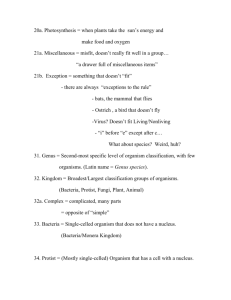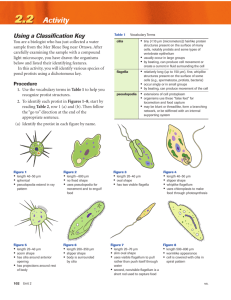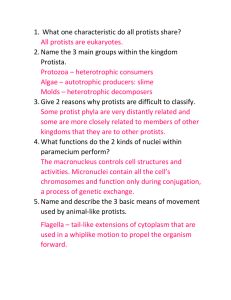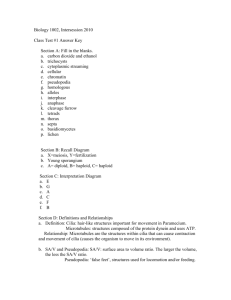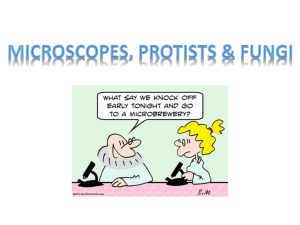Protozoa and Fungi Worksheet: Biology Practice
advertisement
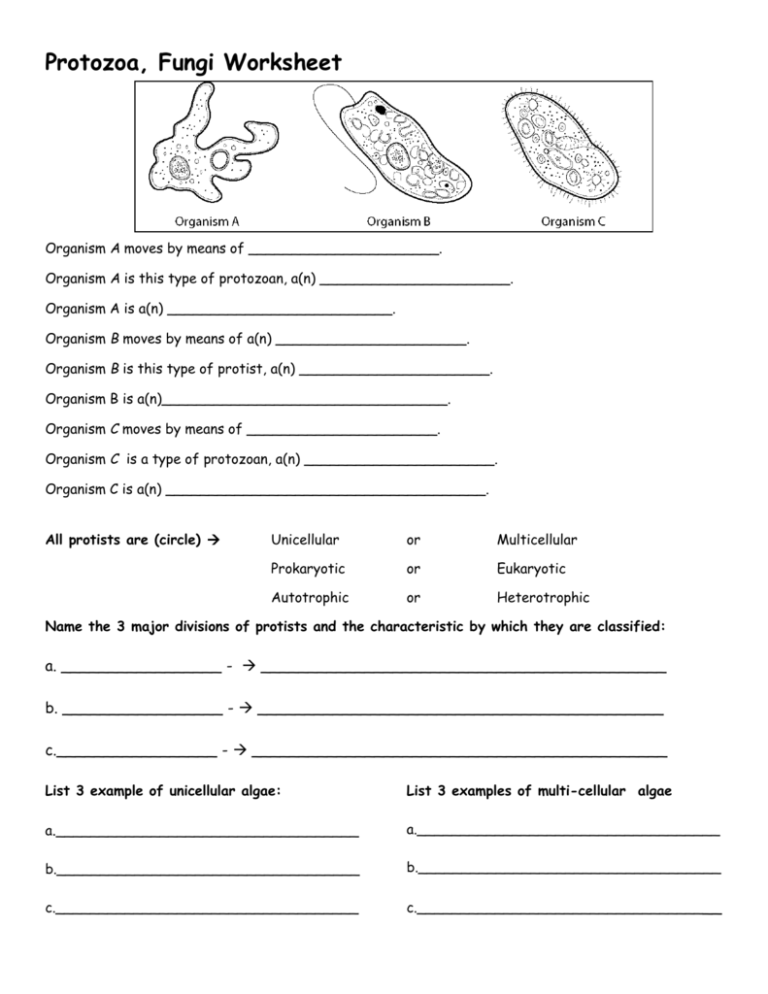
Protozoa, Fungi Worksheet Organism A moves by means of ______________________. Organism A is this type of protozoan, a(n) ______________________. Organism A is a(n) __________________________. Organism B moves by means of a(n) ______________________. Organism B is this type of protist, a(n) ______________________. Organism B is a(n)_________________________________. Organism C moves by means of ______________________. Organism C is a type of protozoan, a(n) ______________________. Organism C is a(n) _____________________________________. All protists are (circle) Unicellular or Multicellular Prokaryotic or Eukaryotic Autotrophic or Heterotrophic Name the 3 major divisions of protists and the characteristic by which they are classified: a. _________________ - ___________________________________________ b. _________________ - ___________________________________________ c._________________ - ____________________________________________ List 3 example of unicellular algae: List 3 examples of multi-cellular algae a.___________________________________ a.___________________________________ b.___________________________________ b.___________________________________ c.___________________________________ c.___________________________________ Multiple Choice: ____1. The animal – like protist are called ________. a. algae c. protozoans b. diatoms d. fungi ____2. The amoeba moves with the use of a false foot called a(n) _______. a. flagella c. chitin b. cilia d. pseudopodia ____3. Fungi have cell walls made of ________. a. cellulose c. plasma b. chitin d. mold ____4. Yeast are a fungi that reproduce by a process where once the parent matures new individuals pinches off the parent this type of asexual reproduction is called ___________. a. budding c. fragmentation b. binary fission d. spores ____5. A lichen is a symbiotic relationship between a fungus and a(n)_________. a. green algae c. another fungi b. plant d. animal ____6. ________ is not a fungi. a. mushroom c. bread mold b. yeast d. euglena ____7. The plant – like protist are called __________. a. protozoans c. fungi b. algae d. diatoms ____8. Some protist use a tail for moving called a(n)__________. a. flagella c. pseudopodia b. cilia d. spores ____9. A reproductive cell that forms without fertilization and produces a new organism is a(n) _______. a. egg c. fragment b. spore d. alternation of generation ____10. Fungi that break down complex organic substances into raw materials that other organisms can use are a. parasites. b. mutualists. c. decomposers. d. autotrophs. ____11. Mycorrihiza is a symbiotic relationship between a fungus and a(n) ________. a. green algae c. another fungi b. plant d. animal ____12. The plasmodium that causes malaria can move from place to place by ____________. a. flagella c. pseudopodia b. cilia d. mosquitoes ____13. Algae gets its food by____________. a. photosynthesis c. decomposition b. capturing prey d. osmosis ____14. Protozoan’s get food by __________. a. photosynthesis c. decomposition b. capturing prey d. osmosis ____ 15. Fungi gets food by _________. a. photosynthesis c. decomposition b. capturing prey d. osmosis ____16. Some protozoan’s move by using the hair like structures moving them like oars on a ship these structures are called ________. a. flagella c. pseudopodia b. cilia d. hair oars ____17. Green algae can reproduce asexually by breaking into pieces and each piece grows into an individual, this type of asexual reproduction is ________. a. spores c. binary fission b. budding d. fragmentation ____ 18. Many protozoa are classified according to a. there method of getting food b. the way that they move c. their method of reproduction d. their habitats ____ 19. An amoeba engulfs food by a. using its oral groove and cilia b. osmosis c. surrounding the food with pseudopodia d. forming a cysts ____ 20. A protozoa that moves by lashing one or more of its whiplike parts is a a. ciliate c. water mold b. sporozoan d. flagellate Use the pictures above to answer the questions below. Questions may have multiple answers. YOU MAY USE THEM MORE THAN ONCE! 1. ____ ____ ____ ____ Which letters from above represent the Protista Kingdom 2. ____ ____ Which letters from above represent the Fungi Kingdom. 3. ____ Amoeba 4. ____ Move by means of cilia A 5. ____ ____ Move by means of a flagella 6. ____ Bread Mold 7. ____ Move by means of a pseudopodia 8. ____ Uses spores to replicate 9. ____ ____ Decomposes 10. ____ ____ Contains a Cell Wall B 11. ____ Euglena 12. ____ Mushroom 13. ____ Paramecium C 14. ____ Volvox 15. ____ ____ Plant-Like Protista 16. ____ ____ Animal-Like Protista D E F

